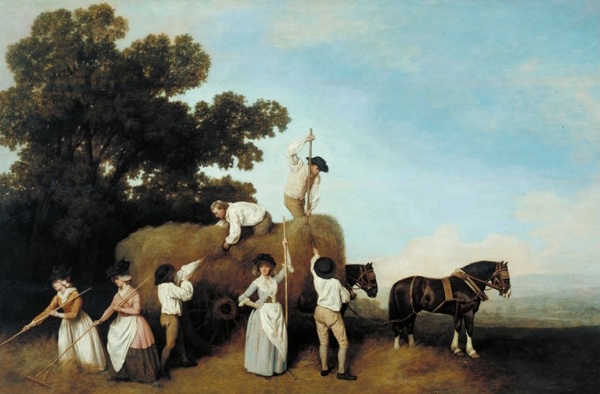
In this month’s column, Suffolk-based artist, educator and presenter Grace Adam looks at three depictions of the harvest
Here are two paintings and a photograph that explore the idea of harvest. George Stubbs gives us rural scenes at the start of the Industrial Revolution. Agnes Denes’ wheat field in Manhattan encourages us to think about food, trade and hunger.
George Stubbs – Reapers 1785

Reapers is one of a pair of paintings by George Stubbs. Born in Liverpool, Stubbs was largely self-taught and made his name painting thoroughbred horses. You may know his famous painting Whistlejacket which hangs in the National Gallery.
Here, a frieze of figures is choreographed into a graceful rhythm echoed in the treeline and emphasised by all those legs and sheaves. The central female figure straightens up from her labour and gazes out of the picture. The church steeple in the background and the presence of the boss on his impressive mount tell us that authority is in place. Even the dog looks up at him leading our eye in that direction.
Given, his farm workers are clean, smart and well fed so an element of romance is involved but at the time the artist’s image of rural life was considered documentary, and without romance. Stubbs sees their labour as heroic. Thomas Gainsborough, his Suffolk-born contemporary was producing romantic pastoral scenes.
The prevailing hierarchy in painting meant that there was great snobbery around Stubbs’s choice of subject-matter. He was classified in his lifetime as a sporting painter, and as such was excluded from full membership of the Royal Academy of Arts. This elitism meant that he was considered an ‘also ran’ until the mid-20th century but is now regarded as one of the most innovative English artists of the eighteenth century.
George Stubbs – Haymakers 1785

Stubbs regularly walked eight or nine miles a day observing and sketching. Interest in landscape painting grew rapidly through the second half of the eighteenth century; one reaction to a world forever changed by The Industrial Revolution.
In Haymakers, a pair of sturdy horses wait patiently on the right. We see seven unfeasibly well-dressed farm workers with their rakes and pitchforks. Carefully stage-lit figures in the foreground are set against the almost glowing stack of hay, and a towering inky green late summer tree.
These labourers, two vertical implements and three diagonal form a right-angled triangle. This time the central female figure, hand on hip looks directly at us. It’s a delightful bit of unlikely choreography, and such a beautiful painting.
Agnes Denes – Wheatfield-A confrontation 1982

What a surprising image. In the early 1980s, on a landfill created by the construction of the Twin Towers, Agnes Denes created an installation called Wheatfield-A confrontation. A two-acre site in Lower Manhattan was planted and harvested by hand. The harvested wheat then travelled to 28 cities around the world in the International Art Show for the end of World Hunger, which provided people with seeds to plant. The hay went to Manhattan’s mounted police to feed their horses.
Denes described the project as a “symbol, a universal concept. It represents food, energy, commerce, world trade, economics. It refers to mismanagement and world hunger. It is an intrusion into the Citadel, a confrontation of High Civilization. Then again, it is also Shangri-La, a small paradise, one’s childhood, a hot summer afternoon in the country, peace. Forgotten values, simple pleasures.”
Visit Grace Adam Artist; @artistgraceadam on Instagram; Twitter and Facebook; and The Art Channel.









Thank you, it’s so interesting to see these three images curated together. I love this approach to art history.
Beautiful words and timely! Love that the haymakers are ‘unfeasibly’ well dressed. Thank you for the insight into these works. I will look anew!
A fantastic read to say the least! Love the Agnes Denes image and reading about her process – so striking!